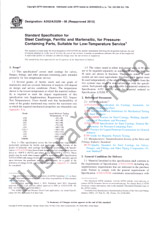Potřebujeme váš souhlas k využití jednotlivých dat, aby se vám mimo jiné mohly ukazovat informace týkající se vašich zájmů. Souhlas udělíte kliknutím na tlačítko „OK“.
ASTM D8126-21
Standard Test Method for Efficient Basicity Determination by Potentiometric Hydrochloric Acid Titration
Přeložit název
NORMA vydána dne 1.11.2021
Informace o normě:
Označení normy: ASTM D8126-21
Datum vydání normy: 1.11.2021
Kód zboží: NS-1043819
Počet stran: 7
Přibližná hmotnost: 21 g (0.05 liber)
Země: Americká technická norma
Kategorie: Technické normy ASTM
Kategorie - podobné normy:
Anotace textu normy ASTM D8126-21 :
Keywords:
base number, EBas, lubricants, marine lubricant, petroleum products, potentiometric titration,, ICS Number Code 75.080 (Petroleum products in general)
Doplňující informace
| Significance and Use |
|
5.1?Lubricants can contain basic constituents that are present as additives. The relative amount of these materials can be determined by titration with acids. The base number is a measurement of the amount of basic substances in the oil under the conditions of the testing procedure. 5.2?A primary objective of a marine cylinder lubricant is the neutralization of sulfuric acid, produced during fuel combustion, to protect the engine from corrosion. The EBas method characterizes the more efficient basic species of the lubricant reacting with acids from the beginning of the neutralization (when the lubricant milieu is basic) until an equilibrium state where the lubricant becomes slightly acidic. The use of hydrochloric acid (HCl) allows differentiating basicities of various strengths during titration. 5.3?In marine lubricants, the constituents that can be considered to have basic properties are primarily organic and inorganic bases coming from the detergent. Basicity can also be brought to the lubricant by other components including dispersants, amino compounds, or any organic basic components. This test method uses the same titration system as that of Test Method D4739, however the evaluation and interpretation of the titration result is different. The hydrochloric acid is used as the titrant in this test method and Test Method D4739, whereas Test Method D2896 uses a stronger acid, perchloric acid. While all three methods can be considered as complementary to evaluate the basicity of lubricants, this test method is only used for marine cylinder lubricants. 5.4?This test method measures only the efficient basicity of the lubricant, which represents only the part of the total basicity, until the point of which the lubricant becomes slightly acidic. It will depend on the components of the formulation itself. In that respect, the EBas cannot be compared to base number given by Test Methods D4739 or D2896. The EBas is then complementary information to the base number, giving performance in efficiency of neutralization of acidic species. |
| 1. Scope |
|
1.1?This test method covers a procedure for the determination of the efficient basicity (EBas) in new marine cylinder lubricants that lubricate the upper part, that is, piston-ring-cylinder area, of two-stroke marine engines. 1.2?This test method has been developed for marine cylinder lubricants, having base number (BN) (measured by Test Method D2896) from 20 mg KOH/g to 100 mg KOH/g, and an EBas from 10 mg KOH/g to 36 mg KOH/g. 1.3?In this test method, only the efficient basicity is determined, corresponding to the components or part of components that have a major role in neutralization of the acidic species formed in the combustion of the fuel in the marine engine. It differentiates between the fastest reacting species and the last one to react like overbasing compounds in detergent (classically mineral calcium carbonate, CaCO3). The values obtained, however, are intended to be compared with the other values obtained by this test method only; base numbers obtained by this test method are not intended to be equal to values by other test methods. 1.4?The values stated in SI units are to be regarded as standard. No other units of measurement are included in this standard. 1.5?This standard does not purport to address all of the safety concerns, if any, associated with its use. It is the responsibility of the user of this standard to establish appropriate safety, health, and environmental practices and determine the applicability of regulatory limitations prior to use. Some specific hazards statements are given in Sections 6 and 7. 1.6?This international standard was developed in accordance with internationally recognized principles on standardization established in the Decision on Principles for the Development of International Standards, Guides and Recommendations issued by the World Trade Organization Technical Barriers to Trade (TBT) Committee. |
Doporučujeme:
Aktualizace technických norem
Chcete mít jistotu, že používáte pouze platné technické normy?
Nabízíme Vám řešení, které Vám zajistí měsíční přehled o aktuálnosti norem, které používáte.
Chcete vědět více informací? Podívejte se na tuto stránku.




 Cookies
Cookies
